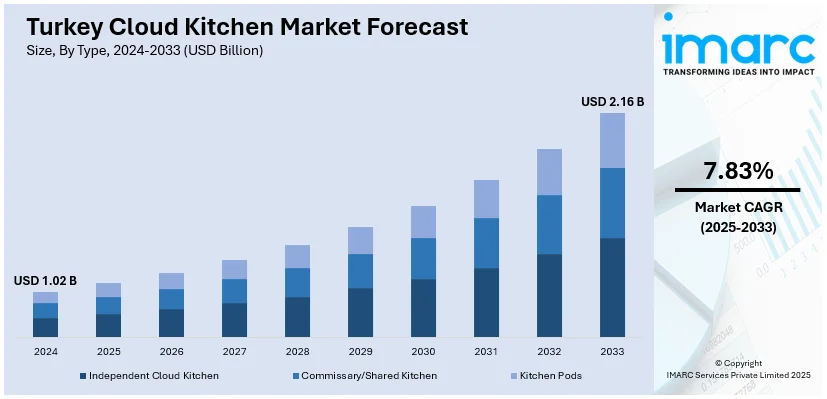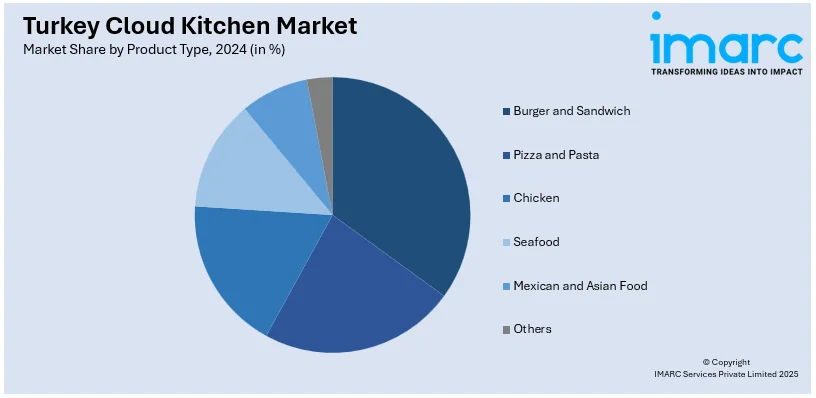
Turkey Cloud Kitchen Market Size, Share, Trends and Forecast by Type, Product Type, Nature, and Region, 2025-2033
Turkey Cloud Kitchen Market Overview:
The Turkey cloud kitchen market size reached USD 1.02 Billion in 2024. The market is projected to reach USD 2.16 Billion by 2033, exhibiting a growth rate (CAGR) of 7.83% during 2025-2033. Strategic partnerships between cloud kitchens and food delivery aggregators are enhancing visibility, order volumes, and operational scalability. Besides this, the widespread use of social media apps on smartphones, which is creating a direct marketing avenue to target younger demographics with visually appealing food promotions, is contributing to the expansion of the Turkey cloud kitchen market share.
|
Report Attribute
|
Key Statistics
|
|---|---|
|
Base Year
|
2024
|
|
Forecast Years
|
2025-2033
|
|
Historical Years
|
2019-2024
|
| Market Size in 2024 | USD 1.02 Billion |
| Market Forecast in 2033 | USD 2.16 Billion |
| Market Growth Rate 2025-2033 | 7.83% |
Turkey Cloud Kitchen Market Trends:
Rising smartphone usage
Increasing smartphone usage is significantly fueling the growth of the market in Turkey. As per industry reports, in the beginning of 2025, 45% of the population in Turkey used smartphones. With a rapidly growing base of tech-savvy users, smartphones have become the primary channel for discovering, ordering, and paying for food online. The portability of smartphones allows people to place orders on the go, fostering impulse purchases and frequent ordering behavior, which is driving the demand for cloud kitchen services. Mobile-friendly interfaces, push notifications, and targeted promotions further engage users, encouraging them to explore diverse cuisines and try new virtual restaurant brands operating without physical dine-in facilities. Additionally, the widespread use of social media apps on smartphones is also creating a direct marketing avenue for cloud kitchens to target younger demographics with visually appealing food promotions and influencer-led campaigns. As internet penetration continues to deepen across Turkey, smartphone-based food ordering is replacing traditional dine-in and takeaway habits, fostering higher order volumes and expanding delivery coverage. This shift in user behavior, fueled by smartphone adoption, is positioning cloud kitchens as an essential part of Turkey’s modern food ecosystem.

To get more information on this market, Request Sample
Strategic partnerships with e-commerce and meal delivery platforms
Strategic partnerships with e-commerce and meal delivery platforms are propelling the Turkey cloud kitchen market growth by enhancing visibility, order volumes, and operational scalability. Collaborating with established aggregators provides cloud kitchens access to large, loyal customer bases without requiring heavy marketing investments, thereby lowering customer acquisition costs. These partnerships also enable kitchens to benefit from advanced logistics networks, ensuring faster delivery times, higher customer satisfaction, and repeat business. Joint promotions, discounts, and loyalty programs co-created with aggregators further strengthen customer engagement, driving higher order frequency. Moreover, e-commerce expansion in Turkey is creating a stronger digital ecosystem, encouraging more people to use online platforms for food purchases. As per the IMARC Group, the Turkey e-commerce market size reached USD 235.1 Billion in 2024. Cloud kitchens also gain from data-sharing agreements with aggregators, leveraging insights into customer preferences and regional demand patterns to optimize menus, pricing, and supply chains. In addition, strategic tie-ups with e-commerce platforms allow bundling of food delivery with other online shopping experiences, making cloud kitchen offerings more accessible and integrated into users’ daily lives. These alliances ultimately aid in enhancing brand visibility, extending delivery reach, and accelerating market penetration, making partnerships a crucial growth factor for Turkey’s evolving cloud kitchen industry.
Turkey Cloud Kitchen Market Segmentation:
IMARC Group provides an analysis of the key trends in each segment of the market, along with forecasts at the country and regional levels for 2025-2033. Our report has categorized the market based on type, product type, and nature.
Type Insights:
- Independent Cloud Kitchen
- Commissary/Shared Kitchen
- Kitchen Pods
The report has provided a detailed breakup and analysis of the market based on the type. This includes independent cloud kitchen, commissary/shared kitchen, and kitchen pods.
Product Type Insights:

- Burger and Sandwich
- Pizza and Pasta
- Chicken
- Seafood
- Mexican and Asian Food
- Others
A detailed breakup and analysis of the market based on the product type have also been provided in the report. This includes burger and sandwich, pizza and pasta, chicken, seafood, mexican and asian food, and others.
Nature Insights:
- Franchised
- Standalone
The report has provided a detailed breakup and analysis of the market based on the nature. This includes franchised and standalone.
Regional Insights:
- Marmara
- Central Anatolia
- Mediterranean
- Aegean
- Southeastern Anatolia
- Black Sea
- Eastern Anatolia
The report has also provided a comprehensive analysis of all the major regional markets, which include Marmara, Central Anatolia, Mediterranean, Aegean, Southeastern Anatolia, Black Sea, and Eastern Anatolia.
Competitive Landscape:
The market research report has also provided a comprehensive analysis of the competitive landscape. Competitive analysis such as market structure, key player positioning, top winning strategies, competitive dashboard, and company evaluation quadrant has been covered in the report. Also, detailed profiles of all major companies have been provided.
Turkey Cloud Kitchen Market News:
- In January 2025, the Turkish cloud kitchen startup Rafinera Cloud Kitchen (RCK) secured USD 2.7 Million in a funding round spearheaded by EFK, the parent company of Cookshop Brands Group, along with Kazancı Holding. This new investment increased Rafinera's total funding to USD 5 Million, raising its valuation to nearly USD 20 Million. The firm intended to enhance its growth and broaden its network under Cookshop’s strategic guidance, with the goal of becoming the largest cloud kitchen chain in Turkey.
- In October 2024, the Turkish cloud kitchen software startup Paket Mutfak raised USD 2.7 Million, increasing its total funding to USD 8.5 Million. This investment would enhance the company's technological framework, aid in expanding its branch network, and elevate customer experience.
Turkey Cloud Kitchen Market Report Coverage:
| Report Features | Details |
|---|---|
| Base Year of the Analysis | 2024 |
| Historical Period | 2019-2024 |
| Forecast Period | 2025-2033 |
| Units | Billion USD |
| Scope of the Report |
Exploration of Historical Trends and Market Outlook, Industry Catalysts and Challenges, Segment-Wise Historical and Future Market Assessment:
|
| Types Covered | Independent Cloud Kitchen, Commissary/Shared Kitchen, Kitchen Pods |
| Product Types Covered | Burger and Sandwich, Pizza and Pasta, Chicken, Seafood, Mexican and Asian Food, Others |
| Natures Covered | Franchised, Standalone |
| Regions Covered | Marmara, Central Anatolia, Mediterranean, Aegean, Southeastern Anatolia, Black Sea, Eastern Anatolia |
| Customization Scope | 10% Free Customization |
| Post-Sale Analyst Support | 10-12 Weeks |
| Delivery Format | PDF and Excel through Email (We can also provide the editable version of the report in PPT/Word format on special request) |
Key Questions Answered in This Report:
- How has the Turkey cloud kitchen market performed so far and how will it perform in the coming years?
- What is the breakup of the Turkey cloud kitchen market on the basis of type?
- What is the breakup of the Turkey cloud kitchen market on the basis of product type?
- What is the breakup of the Turkey cloud kitchen market on the basis of nature?
- What is the breakup of the Turkey cloud kitchen market on the basis of region?
- What are the various stages in the value chain of the Turkey cloud kitchen market?
- What are the key driving factors and challenges in the Turkey cloud kitchen market?
- What is the structure of the Turkey cloud kitchen market and who are the key players?
- What is the degree of competition in the Turkey cloud kitchen market?
Key Benefits for Stakeholders:
- IMARC’s industry report offers a comprehensive quantitative analysis of various market segments, historical and current market trends, market forecasts, and dynamics of the Turkey cloud kitchen market from 2019-2033.
- The research report provides the latest information on the market drivers, challenges, and opportunities in the Turkey cloud kitchen market.
- Porter's five forces analysis assist stakeholders in assessing the impact of new entrants, competitive rivalry, supplier power, buyer power, and the threat of substitution. It helps stakeholders to analyze the level of competition within the Turkey cloud kitchen industry and its attractiveness.
- Competitive landscape allows stakeholders to understand their competitive environment and provides an insight into the current positions of key players in the market.
Need more help?
- Speak to our experienced analysts for insights on the current market scenarios.
- Include additional segments and countries to customize the report as per your requirement.
- Gain an unparalleled competitive advantage in your domain by understanding how to utilize the report and positively impacting your operations and revenue.
- For further assistance, please connect with our analysts.
 Request Customization
Request Customization
 Speak to an Analyst
Speak to an Analyst
 Request Brochure
Request Brochure
 Inquire Before Buying
Inquire Before Buying




.webp)




.webp)












